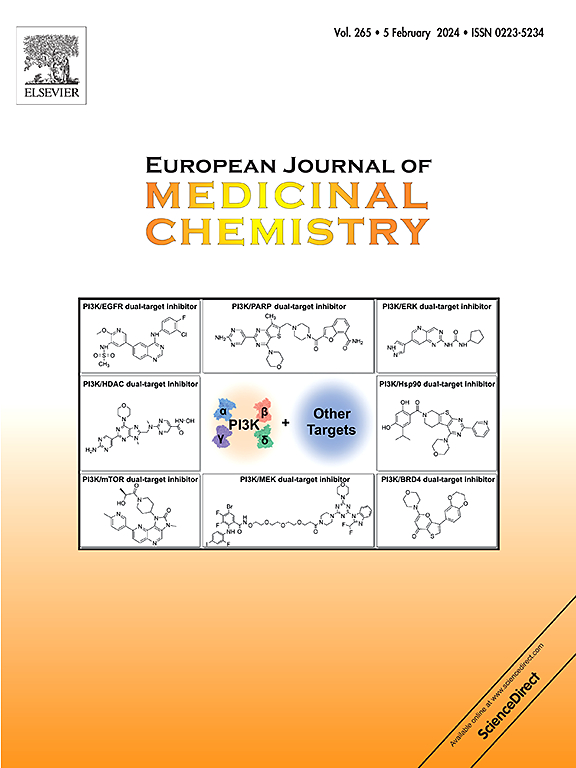Introduction of 1,3-Diethyl-4,5-diphenyl-4,5-dihydro-1H-imidazol-2-ylidene as New Ligand for the Design of Antitumor-Active (NHC)gold(I) Complexes: An Approach to Reduce Ligand Scrambling and to Increase Tumor Cell Selectivity
IF 6
2区 医学
Q1 CHEMISTRY, MEDICINAL
引用次数: 0
Abstract
SS-, RR-, SR- and RR/SS-configured 1,3-diethyl-4,5-diphenyl-4,5-dihydro-1H-imidazol-2-ylidenes were introduced as new imidazoline-based N-heterocyclic carbene (NHC) ligands for the design of antitumor-active (NHC)gold(I) complexes (halido(NHC)gold(I) complexes: chlorido (5a-d), bromido (6a-d), iodido (7a-d); SS,SS-, RR,RR-, SR,SR-, and RR,SS-configured [(NHC)2Au(I)]+ complexes: 8a-d). X-ray structures of the SS-configured complexes 5a-7a showed bis-equatorially arranged phenyl rings and disturbed columnar structures with increased Au-Au distances (> 5.6 Å). The SR-configuration forced the phenyl ring in a synclinal position above the NHC plane allowing only the formation of separated dimers (5c-7c). In case of the [(NHC)2Au(I)]+ complex 8c, single molecules were observed in the crystals. The steric and dynamic conditions reduced ligand scrambling in solution and thus increased stability. The complexes showed higher growth-inhibitory effects in ovarian (A2780wt, A2780cis) than in breast cancer cells (MDA-MB-231, MCF-7) and circumvented the Cisplatin-resistance in A2780 cells (effects in A2780wt = A2780cis). Chlorido- and bromido(NHC)gold(I) complexes caused comparable effects, because of a fast Br/Cl exchange (6a-d → 5a-d). The iodido(NHC)gold(I) complexes 7a-d were more active, due to a partial degradation to 8a-d. The latter were the most cytotoxic compounds of this study. The configuration of the NHC ligand did not influence the cytotoxicity of the complexes. Enantiomers and diastereomers showed the same antimetabolic effects. On the examples of 5a-d and 8a-d, the cellular uptake was studied. The maximum gold levels in A2780wt and MDA-MB-231 cells were achieved within 30 min of incubation. At concentrations corresponding to the IC50 values of the antiproliferative effect (5a-d: 20 μM, 8a-d: 5 μM), 5b, 5c and 5d induced almost the same gold content in A2780wt cells, which was 30-50% lower than that of 5a. The trend of accumulation for [(NHC)2Au(I)]+ complexes was 8d < 8a < 8b < 8c. Furthermore, 5a-d inhibited the cyclooxygenase-1 (COX-1) and thioredoxin reductase (TrxR) and upregulated the glutathione (GSH) level in A2780wt cells. Contrarily, 8a-d did not reduce COX-1 and TrxR activity, but led to moderate GSH down-regulation. The GSH level was not lowered in favour of GSSG, demonstrating that 8a-d influence the formation of GSH.© 2017 Elsevier Inc. All rights reserved.

引入1,3-二乙基-4,5-二苯基-4,5-二氢- 1h -咪唑-2-吡啶作为抗肿瘤活性(NHC)金(I)配合物的新配体:减少配体混乱和提高肿瘤细胞选择性的方法
介绍了SS-、RR-、SR-和RR/SS配置的1,3-二乙基-4,5-二苯基-4,5-二氢- 1h -咪唑-2-酰基作为新型咪唑基n -杂环羰基(NHC)配体,用于设计抗肿瘤金(NHC)配合物(卤代(NHC)金(I)配合物:氯代(5 -d)、溴代(6 -d)、碘代(7 -d);SS,SS-, RR,RR-, SR,SR-和RR,SS配置[(NHC)2Au(I)]+配合物:8a-d)。ss构型配合物5a-7a的x射线结构显示出双赤道排列的苯环和随着Au-Au距离的增加而扰动的柱状结构(>;5.6)。sr构型迫使苯环在NHC平面上方的向斜位置,只允许形成分离的二聚体(5c-7c)。对于[(NHC)2Au(I)]+配合物8c,在晶体中观察到单个分子。空间和动态条件减少了配体在溶液中的乱序,从而提高了稳定性。这些复合物在卵巢癌细胞(A2780wt, A2780cis)中的生长抑制作用高于乳腺癌细胞(MDA-MB-231, MCF-7),并绕过了A2780细胞的顺铂耐药(A2780wt = A2780cis)。氯-和溴(NHC)金(I)配合物由于Br/Cl的快速交换(6a-d→5a-d)而具有类似的效果。碘(NHC)金(I)配合物7a-d由于对8a-d的部分降解而更有活性。后者是本研究中最具细胞毒性的化合物。NHC配体的构型不影响配合物的细胞毒性。对映体和非对映体具有相同的抗代谢作用。以5a-d和8a-d为例,研究了细胞摄取。A2780wt和MDA-MB-231细胞的最高金水平在孵育30分钟内达到。在相应浓度下(5a-d: 20 μM, 8a-d: 5 μM), 5b、5c和5d诱导的A2780wt细胞含金量几乎相同,比5a低30-50%。[(NHC)2Au(I)]+络合物的积累趋势为8d <;8 & lt;8 b & lt;8 c。此外,5a-d抑制A2780wt细胞环氧化酶-1 (COX-1)和硫氧还蛋白还原酶(TrxR),上调谷胱甘肽(GSH)水平。相反,8a-d不降低COX-1和TrxR活性,但导致GSH适度下调。GSH水平没有降低,有利于GSSG,表明8a-d影响GSH的形成。©2017 Elsevier Inc.版权所有。
本文章由计算机程序翻译,如有差异,请以英文原文为准。
求助全文
约1分钟内获得全文
求助全文
来源期刊
CiteScore
11.70
自引率
9.00%
发文量
863
审稿时长
29 days
期刊介绍:
The European Journal of Medicinal Chemistry is a global journal that publishes studies on all aspects of medicinal chemistry. It provides a medium for publication of original papers and also welcomes critical review papers.
A typical paper would report on the organic synthesis, characterization and pharmacological evaluation of compounds. Other topics of interest are drug design, QSAR, molecular modeling, drug-receptor interactions, molecular aspects of drug metabolism, prodrug synthesis and drug targeting. The journal expects manuscripts to present the rational for a study, provide insight into the design of compounds or understanding of mechanism, or clarify the targets.

 求助内容:
求助内容: 应助结果提醒方式:
应助结果提醒方式:


